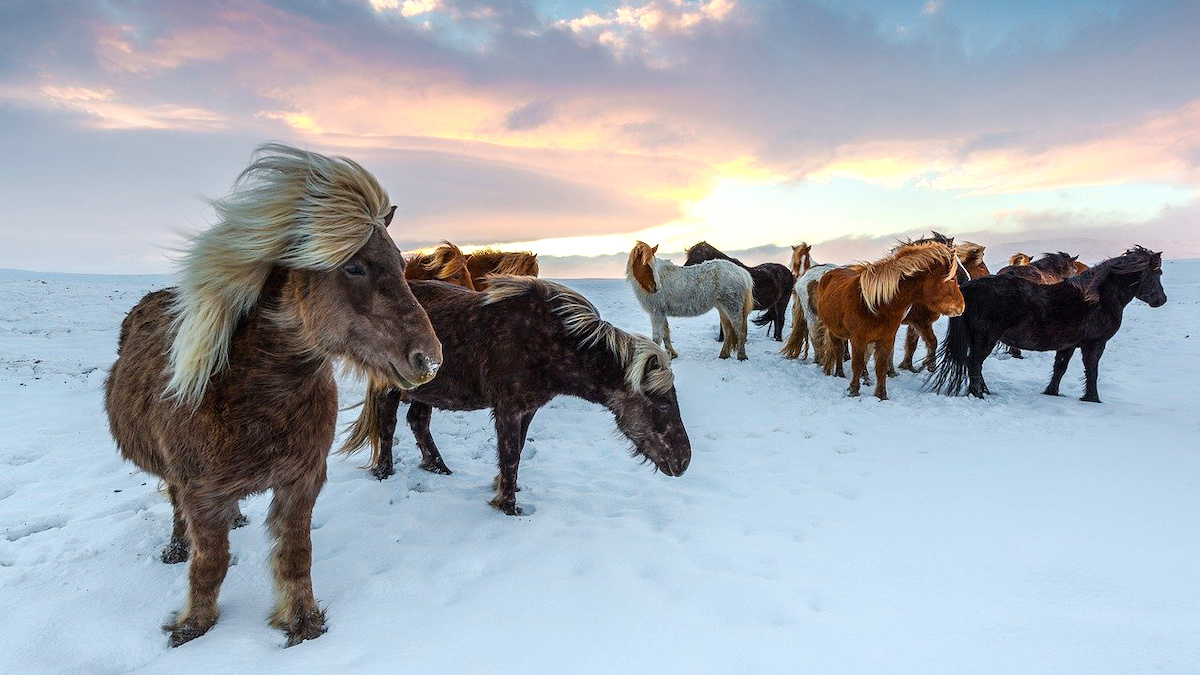

Islandic Horses walk around grazing and trampling over snow. A new study found that herds of horses, bison and reindeer could be used to fight off the melting of the permafrost in the Arctic. Susanne Stöckli / Pixabay
Arctic winters are meant to be frigid, but because of rising temperatures and climate change, they aren’t cold enough. The permafrost, the thick subsurface layer of frozen soil that stores one of the world’s largest natural reserves of carbon, is thawing. As it does, it releases potent greenhouse gases that accelerate climate change. European scientists have now found that resettling massive herds of large herbivores could combat this effect and save up to 80 percent of all permafrost soils around the globe until 2100.
The study, published in the Nature journal Scientific Reports on Tuesday, focuses on wholistic “ecosystem management practices” that “[integrate] fauna dynamics into complex Earth System models.” Lead scientist and permafrost expert Christian Beer from Universität Hamburg’s Center for Earth System Research and Sustainability (CEN) found that introducing and managing reindeer, horses, bison and other herbivores into Arctic ecosystems can save the permafrost soils and stall climate change.
Beer drew inspiration from the late Pleistocene era, when large herds of herbivores roamed most of Northern Eurasia maintaining a grassland ecosystem in the Arctic called the mammoth steppe ecosystem, notes the study.
The productive ecosystem actually pulled large quantities of carbon from the earth’s atmosphere into the soil where it froze, reports Climate CoLab. Over tens of thousands of years, the carbon-infused soils built up into our modern permafrost.
This ecosystem existed up until the end of the last ice age when wooly mammoths and other big mammals died off and the mammoth steppe vanished. Today, as the permafrost thaws, ancient methane and carbon dioxide are released.
Beer’s study explores what would happen if a similar ecosystem could be recreated in the modern era to prevent loss of the permafrost. Luckily, he doesn’t need to find wooly mammoths.
Russian scientists Sergey and Nikita Zimov resettled herds of bison, wisents, reindeer and horses at Pleistocene Park in Siberia 20 years ago to study how restoring the mammoth steppe ecosystem will positively affect global climate, reports Climate CoLab.
At Pleistocene Park, the winter air (minus 40 degrees Celsius) is far colder than the permafrost (minus 10 degrees Celsius), the study notes. “Thick snowfall insulates the ground from the much colder air, keeping it ‘warm.'”
As the animals graze, their hooves scatter and compress the snow cover, dramatically reducing the insulating effect and allowing for more “freezing Siberian air [to reach] more deeply into the ground’s permafrost,” explains Pleistocene Park. This slows the thawing of the permafrost even in a warmer climate, reports Climate CoLab.
Beer, the Zimovs and their research partners compared the effect of grazing herds on snow depth and soil temperatures at Pleistocene Park and other Arctic locations in Europe. The study reports that herds in the Park cut snow cover height in half and reindeer in Sweden lowered snow cover by 73 percent. Comparing soil temperatures inside and outside of the fenced Pleistocene Park during winter revealed a mean annual difference of −1.9 degrees Celsius where animals had grazed.
The study explains the huge potential upside of this experiment. “Since most populations of large herbivores like reindeer and muskoxen are directly managed by humans, either by hunting or management,” it reports, “the herbivore community can also be manipulated even more by reintroducing lost components of the Arctic herbivore assembly.”
Beer said, “This type of natural manipulation in ecosystems that are especially relevant for the climate system has barely been researched to date – but holds tremendous potential,” reported a Universität Hamburg article.
“If emissions continue to rise unchecked … we can expect to see a 3.8-degree Celsius increase in permafrost temperatures, which would cause half of all permafrost to thaw,” the article reported. Adding animals lowers that warming by 44 percent, to 2.1 degrees Celsius, which is enough to preserve 80 percent of the world’s permafrost.
Beer’s team also explored what would happen if some, but fewer, grazers were resettled. He admitted, “It may be utopian to imaging resettling wild animal herds in all the permafrost regions of the Northern Hemisphere,” reported Universität Hamburg.
Critically, Beer’s results show that fewer animals would still produce a cooling effect. “What we’ve shown here is a promising method for slowing the loss of our permanently frozen soils, and with it, the decomposition and release of the enormous carbon stockpiles they contain,” the earth system expert told Universität Hamburg.
- Ozone-Depleting Substances May Have Driven Arctic Warming ...
- Arctic Permafrost Is Melting so Fast, It's Gouging Holes in the ...
- Rewilding the Arctic Could Slow the Climate Crisis - EcoWatch
- Kicking Up Controversy With Wild Horses in the West - EcoWatch
- Thawing Permafrost Is Full of Ice-Forming Particles That Could Get Into Atmosphere - EcoWatch

 233k
233k  41k
41k  Subscribe
Subscribe 